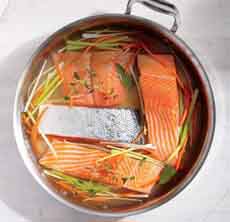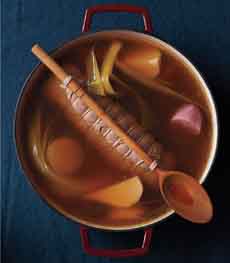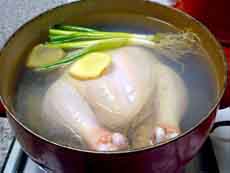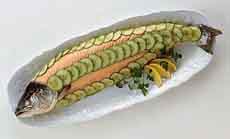TIP OF THE DAY: Poach Your Proteins

|
Poaching food is a topic that doesn’t come up much these days. The age-old moist-heat cooking technique simply submerges raw food in a liquid. The technique cooks the food without pulling the moisture from it: The protein is moist, never dry. The food cooks at a relatively low temperature (about 160°–180°F), which is especially good for delicate foods (eggs, fish) that might fall apart or dry out with other cooking methods. Heartier foods—an entire beef tenderloin or chicken—work equally well. Decades ago, when we tried to master the art of French cooking, we purchased a large, oblong fish poacher, a pan created to poach a whole fish. Cold poached salmon was a mainstay of French cuisine, served with dill sauce and marinated cucumbers. We loved it and ate it regularly, at the numerous classic French restaurants that graced New York City back then. It looked easy to make, and it was. But we subsequently discovered that serving it nicely takes a bit of training. The captains at the French restaurants new how to cut neat slices, avoiding the bones. Our salmon looked like it had been hacked by starving hordes. Sigh. We stuck the poacher in the cupboard (until, 10 years later, we learned to poach an entire beef tenderloin, a cinch tot slice), and stuck to poaching fillets. They require zero skill to serve. START POACHING TODAY Just about any food can be poached, poaches up moist and flavorful, and can be served warm or cold. Poaching proteins are an easy and healthy preparation; all your healthcare providers and trainers approve. Poaching has: You end up with an extra dish, or part thereof. The poaching liquid becomes a delicious broth that can be served later, thickened into a sauce, or used in other recipes. WHAT’S IN THE POACHING LIQUID? The poaching liquid can include whatever flavors you want, from the base to the add-ins. Our wine editor, Kris Prasad, who taught us to poach a tenderloin, advised: “Toss in whatever you have: leftover wine, herbs, soy sauce instead of salt, a splash of balsamic, citrus juice or vinegar for tartness. Anything works.” The poaching liquid can be: In terms of add-ins: Add in whatever flavors you like, from classic mirepoix—carrots, celery, onions—and fresh herbs, to the less obvious—cardamom, cinnamon sticks, star anise, whole nutmeg, etc. |
|
|
There are recipes galore online, and plenty of videos on YouTube, for anything you might want to poach. Don’t wait to try them: You may discover that poaching proteins is your favorite food discovery of the year. |
||





